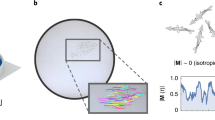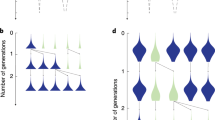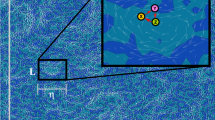Abstract
Clustering of organisms can be a consequence of social behaviour, or of the response of individuals to chemical and physical cues1. Environmental variability can also cause clustering: for example, marine turbulence transports plankton2,3,4,5,6,7,8 and produces chlorophyll concentration patterns in the upper ocean9,10,11. Even in a homogeneous environment, nonlinear interactions between species12,13,14 can result in spontaneous pattern formation. Here we show that a population of independent, random-walking organisms (‘brownian bugs’), reproducing by binary division and dying at constant rates, spontaneously aggregates. Using an individual-based model, we show that clusters form out of spatially homogeneous initial conditions without environmental variability, predator–prey interactions, kinesis or taxis. The clustering mechanism is reproductively driven—birth must always be adjacent to a living organism. This clustering can overwhelm diffusion and create non-poissonian correlations between pairs (parent and offspring) or organisms, leading to the emergence of patterns.
This is a preview of subscription content, access via your institution
Access options
Subscribe to this journal
Receive 51 print issues and online access
$199.00 per year
only $3.90 per issue
Buy this article
- Purchase on Springer Link
- Instant access to full article PDF
Prices may be subject to local taxes which are calculated during checkout



Similar content being viewed by others
References
Flierl, G., Grünbaum, D., Levin, S. & Olson, D. From individuals to aggregations: the interplay between behaviour and physics. J. Theor. Biol. 196, 397–454 (1999).
Abraham, E. R. The generation of plankton patchiness by turbulent stirring. Nature 391, 577–580 (1998).
Denman, K. L., Okubo, A. & Platt, T. The chlorophyll fluctuation spectrum in the sea. Limnol. Oceanogr. 22, 1033–1038 (1977).
Franks, P. J. S. Spatial pattern in dense algal blooms. Limnol. Oceanogr. 42, 1297–1305 (1997).
Kierstead, H. & Slobodkin, L. B. The size of water masses containing plankton blooms. J. Mar. Res. 12, 141–147 (1953).
Neufeld, Z., López, C. & Haynes, P. H. Smooth-filament transition of active tracer fields stirred by chaotic advection. Phys. Rev. Lett. 82, 2606–2609 (1999).
Robinson, A. R. On the theory of advective effects on biological dynamics in the sea. Proc. R. Soc. Lond. A 453, 2295–2324 (1997).
Steele, J. H. & Henderson, E. W. A simple model for plankton patchiness. J. Plankton Res. 14, 1397–1403 (1992).
Gower, J. F. R., Denman, K. L. & Holyer, R. J. Phytoplankton patchiness indicates the fluctuation spectrum of mesoscale oceanic structure. Nature 288, 157–159 (1980).
Lesieur, M. & Sadourny, R. Satellite-sensed turbulent ocean structure. Nature 294, 673 (1980).
Abraham, E. R. et al. Importance of stirring in the development of an iron-fertilized phytoplankton bloom. Nature 407, 727–730 (2000).
Durrett, R. & Levin, S. The importance of being discrete (and spatial). Theor. Pop. Biol. 46, 363–394 (1994).
Levin, S. & Segel, L. A. Hypothesis for origin of planktonic patchiness. Nature 259, 659 (1976).
Segel, L. A. & Jackson, J. L. Dissipative structure: an explanation and an ecological example. J. Theor. Biol. 37, 545–559 (1972).
Skellam, J. G. Random dispersion in theoretical populations. Biometrika 38, 196–218 (1951).
Keeling, M. J., Mezić, I., Hendry, R. J., McGlade, J. & Rand, D. A. Characteristic length scales of spatial models in ecology via fluctuation analysis. Phil. Trans. R. Soc. Lond. B 352, 1589–1601 (1997).
Pascual, M. & Levin, S. A. From individuals to population densities: searching for the intermediate scale of nontrivial determinism. Ecology 80, 2225–2236 (1999).
Rand, D. A. & Wilson, H. B. Using spatio-temporal chaos and intermediate scale determinism in artificial ecologies to quantify spatially extended systems. Proc. R. Soc. Lond. B 259, 55–63 (1995).
Batchelor, G. K. The effect of turbulence on material lines and surfaces. Proc. R. Soc. Lond. 213, 349–366 (1952).
Batchelor, G. K. Small-scale variation of convected quantities like temperature in turbulent fluid. Part 1. General discussion and the case of small conductivity. J. Fluid Mech. 5, 113–133 (1959).
Kraichnan, R. H. Convection of a passive scalar by a quasi-uniform random stretching field. J. Fluid Mech. 64, 737–762 (1974).
Pierrehumbert, R. T. On tracer microstructure in the large-eddy dominated regime. Chaos Solitions Fractals 4, 1091–1110 (1994).
van Kampen, N. G. Stochastic Processes in Physics and Chemistry Ch. 2 (North-Holland, Amsterdam, 1981).
Pierrehumbert, R. T. in Nonlinear Phenomena in Atmospheric and Oceanic Sciences Ch. 2 (Springer, New York, 1991).
Harris, T. E. The Theory of Branching Processes Ch. 1 (Springer, Berlin, 1963).
Le Gall, J. F. Spatial Branching Processes, Random Snakes and Partial Differential Equations, Lectures in Mathematics, ETH Zürich (Birkhäuser, Basel, 1999).
Acknowledgements
We thank E. Ben-Naim, R. Durrett, G. Flierl, P. Krapivsky, P. Morrison and F. Williams for discussion.
Author information
Authors and Affiliations
Corresponding author
Rights and permissions
About this article
Cite this article
Young, W., Roberts, A. & Stuhne, G. Reproductive pair correlations and the clustering of organisms. Nature 412, 328–331 (2001). https://doi.org/10.1038/35085561
Received:
Accepted:
Issue Date:
DOI: https://doi.org/10.1038/35085561
This article is cited by
-
Patchy nuclear chain reactions
Communications Physics (2021)
-
Diel vertical migration promotes zooplankton horizontal patchiness
Journal of Oceanography (2021)
-
Turbulent coherent structures and early life below the Kolmogorov scale
Nature Communications (2020)
-
Movement patterns of the grey field slug (Deroceras reticulatum) in an arable field
Scientific Reports (2020)
-
Sustainability of spatially distributed bacteria-phage systems
Scientific Reports (2020)
Comments
By submitting a comment you agree to abide by our Terms and Community Guidelines. If you find something abusive or that does not comply with our terms or guidelines please flag it as inappropriate.



